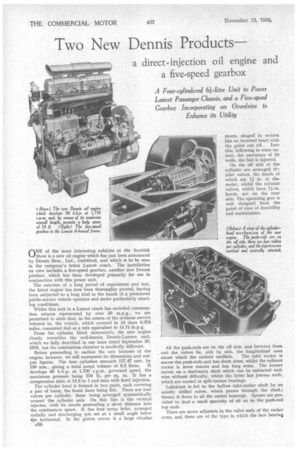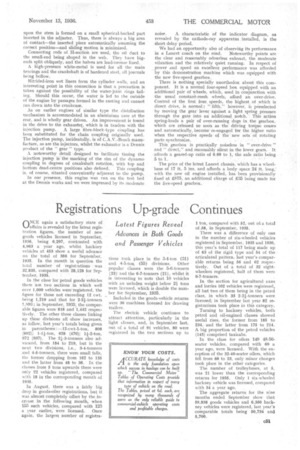Two New Dennis Products
Page 108

Page 109

If you've noticed an error in this article please click here to report it so we can fix it.
a direct-injection oil engine and a five-speed gearbox
A Four-cylinderd 6i-litre Unit to Power Lancet Passenger Chassis, and a Five-sped Gearbox Incorporating an Overdrive to Enhance its Utility
0" of the most interesting exhibits at the Scottish Show is a new oil engine which has just been announced by Dennis Bros., Ltd., Guildford, and which is to be seen in the company's latest Lancet coach. The installation on view includes a five-speed gearbox, another new Dennis product, which has been developed primarily for use in conjunction with this power unit.
The outcome of a long period of experiment and test, the latest engine has now been thoroughly proved, having been subjected to a long trial in the hands of a prominent public-service vehicle operator and under particularly exacting conditions.
Whilst this unit in a Lancet coach has recorded consumption returns represented by over 20 m.p.g., we are permitted to state that, in the course of the arduous service referred to, the vehicle, which covered in 14 days 4,074 miles, consumed fuel at a rate equivalent to 14.71 m.p.g.
From the cylinder block downwards, the new engine closely resembles the well-known Dennis-Lanova unit, which we fully described in our issue dated September 20, 1935, but the combustion chamber is markedly different.
Before proceeding to outline the new features of the engine, however, we will enumerate its dimensions and output figures. The four cylinders measure 117.47 mm. by 150 mm., giving a total swept volume of 6.5 litres. It develops 80 b.h.p. at 1,750 r.p.m. governed speed, the maximum pressure being 750 lb. per sq. in. It has a compression ratio of 13.8 to 1 and runs with fixed injection.
The cylinder head is formed in two parts, each covering a pair of bores, the lower faces being flat. There are four valves per cylinder, these being arranged symmetrically around the cylinder axis. On this line is the vertical injector, with its nozzle protruding a short distance into the combustion space. It has four spray holes, arranged radially and discharging jets set at a small angle below the horizontal. In the piston crown is a large circular c50 recess, shaped in section like an inverted heart with the point cut off. Into this, following to some extent, the curvature of its walls, the fuel is injected.
On the off side of the cylinder are arranged th inlet valves, the heads of which are 11 in. in diameter, whilst the exhaust valves, which have 1s-in, heads, are on the near side. The operating gear is well designed from the point of view of durability and maintenance.
All the push-rods are on the off side, and between them and the valves lie, side by side, the longitudinal axes about which the rockers oscillate. The inlet rocker is nearer the push-rods and has short arms, whilst the exhaust rocker is more remote and has long arms. The former moves on a stationary shaft which can be extracted endwise without difficulty, whilst the latter has journal ends, which are carried in split-bronze bearings.
Lubricant is fed to the hollow inlet-rocker shaft by an axially drilled screw, which passes through . the shaft; thence it flows to all the rocker bearings. Spouts are provided to lead a small quantity of oil on to the push-rod top ends.
There are screw adjusters in the valve ends of the rocker arms, and these are of the type in which the face bearing upon the stem is formed on a small spherical-backed part inserted in the adjuster. Thus, there is always a, big area of contact—the inserted piece automatically assuming the correct position—and sliding motion is minimized.
Connecting rods of H-section are used, the oil duct to the small-end being shaped in the web. They have bigends split obliquely, and the halves are lead-bronze lined.
A high-pressure white-metal is used for all the main bearings and the crankshaft is of hardened steel, all journals being hollow.
Nitrided-iron wet liners form the cylinder walls, and an interesting point in this connection is that a precaution is taken against the possibility of the water-joint rings failing. Should this occur, the water is led to the outside of the engine by passages formed in the casting and cannot run down into the crankcase.
As on earlier engines of similar type the distribution mechanism is accommodated in an aluminium case at the rear, and is wholly gear driven. An improvement is found in the drive to the exhauster, which is in tandem with the injection pump. A large fibre-block-type coupling has been substituted for the chain coupling originally used. The injection pump, incidentally, is of C.A.V.-Bosch manufacture, as are the injectors, whilst the exhauster is a Dennis product of the " gear " type.
A noteworthy detail designed to facilitate timing the injection pump is the marking of the rim of the dynamo coupling in degrees of crankshaft rotation, with top and bottom dead-centre positions also defined. This coupling is, of course, situated conveniently adjacent to the pump.
In our presence, this engine was run on the test bed at the Dennis works and we were impressed by its moderate noise. A characteristic of the indicator diagram, as revealed by the cathode-ray apparatus installed, is the short delay period.
We had an opportunity also of observing its performance in a Lancet coach on the road. Noteworthy points are the clear and reasonably odourless exhaust, the moderate vibration and the relatively quiet running. In respect of power and speed an excellent performance was afforded by this demonstration machine which was equipped with the new five-speed gearbox.
There is nothing specially unorthodox about this component. It is a normal four-speed box equipped with an additional pair of wheels, which, used in conjunction with the usual constant-mesh wheels, afford an over-drive. Control of the first four speeds, the highest of which is direct drive, is normal ; " fifth," however, is preselected by moving the gear • lever against a light spring pressure through the gate into an additional notch. • This action spring-loads a pair of over-running dogs in the gearbox, which are released so soon as the driving torque ceases and automatically; become re-engaged for the higher ratio when the respective speeds • of thenew sets of rotating
parts synchronize. • ..
This gearbox is practically noiseless in " over-drive " and " direct," and reasonably Silent in the lower gears. It affords a geaxed-up ratio of 0.69 to 1, the axle ratio being. 5 to 1.
The price of the latest Lancet chassis, which has a wheelbase of 1.7 ft. 5 ins, and affords a body space 24 ft. long,' with the new oil engine installed, has been provisionally fixed at 2875, an additional charge of 235 being made for the five-speed gearbox.








































































































































































